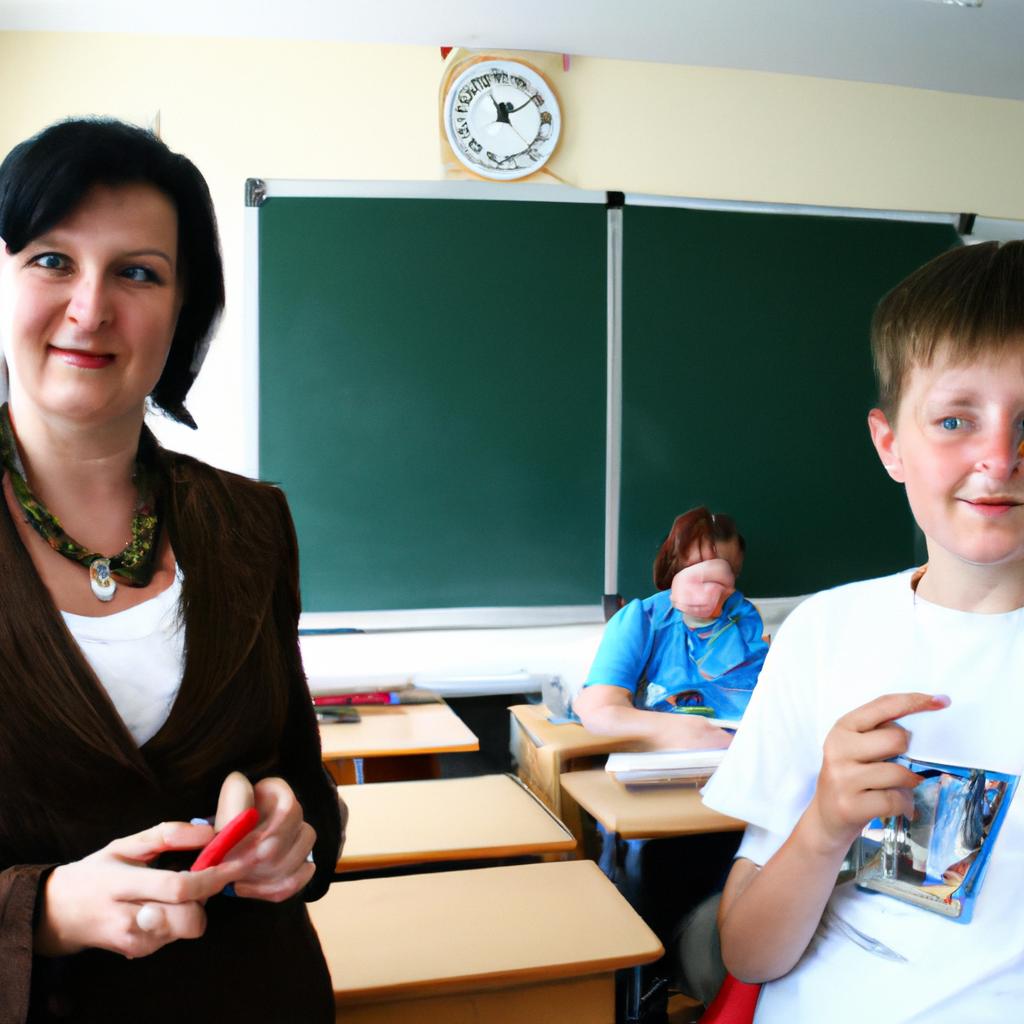In today’s rapidly evolving society, the school curriculum plays a crucial role in shaping individuals and preparing them for their future roles as active citizens. The design of an effective curriculum takes into consideration various factors such as societal needs, cultural diversity, and the aspirations of individuals. For instance, imagine a hypothetical scenario where a group of educators is tasked with developing a new curriculum for a diverse urban high school. They would need to consider not only the academic subjects but also incorporate elements that promote social awareness, critical thinking skills, and empathy towards others.
The relationship between the school curriculum and society is multifaceted and complex. On one hand, the curriculum should reflect the values and norms of the wider society it serves; on the other hand, it has the potential to influence and shape societal attitudes and behaviors. A comprehensive understanding of this dynamic interaction between education systems and society is essential for policymakers, educators, and researchers alike. By examining how different societies have approached curricular reforms throughout history or analyzing case studies from around the world, we can gain insights into successful practices while identifying areas that require improvement to ensure students are adequately prepared to navigate an ever-changing global landscape. This article provides an overview of these important considerations within the broader context of society and people in order to ensure the development of a relevant and effective curriculum that equips students with the necessary knowledge, skills, and values to thrive in the 21st century.
Historical Background
Education has always played a crucial role in shaping societies and individuals. Understanding the historical context of school curriculum provides valuable insights into its development and evolution over time. Taking a closer look at one particular case study, we can gain a deeper understanding of how societal changes have influenced educational practices.
One notable example is the implementation of standardized curricula in early 20th century America. As industrialization swept across the nation, there was an increasing need to prepare students for the workforce. The introduction of subject-specific courses aimed to equip individuals with practical skills that could contribute to economic growth. This shift towards vocational education reflected society’s emphasis on productivity and efficiency.
To further explore this topic, let us delve into four key factors that have shaped the school curriculum throughout history:
-
Socioeconomic Factors:
- Economic conditions
- Social class disparities
- Labor demands
-
Technological Advances:
- Impact on teaching methods
- Integration of technology into curriculum
- Preparation for future workplace requirements
-
Cultural Influences:
- Values and beliefs embedded within curriculum
- Inclusion or exclusion of diverse perspectives
- Preservation of cultural heritage through education
-
Government Policies:
- National education standards
- Education reform movements
- Influence of political ideologies on curriculum decisions
Examining these factors in greater detail allows us to understand how societal values, technological advancements, cultural shifts, and governmental policies have all contributed to shaping school curricula over time.
As we transition into exploring the next section about Curriculum Development Process, it becomes evident that examining historical background is essential for comprehending why certain approaches were adopted and how they continue to impact contemporary educational systems today.
Curriculum Development Process
In examining the historical background of school curriculum, it is important to understand how societal changes have influenced the education system. One notable example is the introduction of vocational training programs in response to the Industrial Revolution. As industries expanded rapidly, schools began incorporating practical skills into their curricula to prepare students for specific occupations. This shift reflected a broader recognition of the need for education that aligns with societal needs and economic demands.
The development process of school curriculum has evolved over time to address various educational goals. To understand this process, we can identify several key stages:
-
Needs Assessment:
- Identification of gaps or deficiencies in existing curriculum.
- Evaluation of societal and individual needs.
- Consideration of cultural and demographic factors.
-
Design and Planning:
- Determining learning objectives aligned with desired outcomes.
- Selecting appropriate teaching strategies and resources.
- Structuring content based on subject areas or interdisciplinary approaches.
-
Implementation:
- Delivery of planned curriculum through instructional methods.
- Adaptation to diverse learner characteristics and needs.
- Ongoing assessment and monitoring for effectiveness.
-
Evaluation and Revision:
- Continuous evaluation of curriculum outcomes.
- Feedback collection from stakeholders (students, teachers, parents).
- Use of data-driven insights to inform revisions or improvements.
- Recognition of changing societal needs
- Alignment between education and economic demands
- Empowerment through practical skill acquisition
- Evolution driven by continuous feedback loops
Furthermore, to visualize the interconnectedness between history, society, people, and curriculum development, consider the following table:
| History | Society | People | |
|---|---|---|---|
| Role | Shaping context | Influenced by | Recipients |
| Impact | Reflective | Transformative | Beneficiaries |
| Dynamic | Evolving | Adaptive | Developmental |
| Outcome | Lessons learned | Social progress | Personal growth |
In summary, understanding the historical background of school curriculum and its development process reveals a nuanced perspective on how education has evolved to meet societal demands. The recognition of changing needs, alignment with economic realities, practical skill acquisition, and continuous improvement are key elements that have shaped curriculum design over time. This foundation will now be explored further in the subsequent section on current curriculum models, highlighting their relevance in today’s educational landscape.
Current Curriculum Models
Transitioning from the previous section on the curriculum development process, it is essential to understand how this process aligns with society and its people. To illustrate this connection, let us consider a hypothetical case study of a school in an urban setting that aims to develop a new curriculum that addresses the needs and challenges faced by its diverse student population.
When embarking on curriculum development, schools must take into account several key factors that influence their decision-making process:
-
Contextual Analysis:
- Schools must conduct a thorough analysis of their specific societal context, considering factors such as cultural diversity, socioeconomic disparities, and community values.
- This step allows educators to gain insights into the unique needs and aspirations of their students and tailor the curriculum accordingly.
-
Stakeholder Involvement:
- Engaging various stakeholders like teachers, parents, students, and community members ensures that multiple perspectives are considered during curriculum development.
- By involving these individuals throughout the process, schools can foster collaboration and create curricula that reflect the collective goals and interests of all involved parties.
-
Research-Based Approaches:
- Drawing upon educational research helps inform decision-making related to curriculum design.
- Utilizing evidence-based practices supports effective teaching strategies while also ensuring alignment with existing pedagogical theories.
-
Flexibility for Adaptation:
- Recognizing that societies evolve over time, curricular frameworks should be flexible enough to accommodate changes within communities.
- The ability to adapt enables schools to remain responsive to emerging needs and prepare students for future demands.
To further emphasize the interplay between society and curriculum development, we present a table highlighting four social influences on the process:
| Social Influences | Impact on Curriculum Development |
|---|---|
| Cultural Diversity | Encourages inclusive content |
| Economic Factors | Shapes vocational training |
| Technological Advancements | Incorporates digital literacy |
| Environmental Concerns | Promotes sustainability education |
By considering these influences, schools can develop curricula that not only address academic goals but also contribute to the holistic development of students. Therefore, curriculum development should be seen as an iterative and dynamic process, constantly evolving in response to societal changes.
Transitioning into the subsequent section on the influence of social factors, it is evident that understanding how society impacts curriculum development is crucial for creating educational programs that meet the diverse needs of learners.
Influence of Social Factors
In the previous section, we explored various current curriculum models that are commonly used in schools today. Now, let us delve into the influence of social factors on school curricula. To illustrate this, consider a hypothetical case study: a high school located in an economically disadvantaged neighborhood where many students come from low-income families.
One prominent social factor affecting the curriculum is socioeconomic status. In schools like the one described above, it becomes crucial to design a curriculum that addresses the specific needs and challenges faced by students from low-income backgrounds. This may involve incorporating practical life skills such as financial literacy or job readiness training into the curriculum to equip these students with tools for success beyond graduation.
Another influential social factor is cultural diversity within classrooms. Schools need to ensure that their curricula reflect and celebrate different cultures, promoting inclusivity and fostering positive identity development among all students. For example, history lessons could incorporate diverse perspectives and narratives, allowing students to gain a more comprehensive understanding of historical events from multiple viewpoints.
Moreover, societal values play a significant role in shaping educational goals and content. As societies evolve over time, so too must curricula adapt to reflect changing norms and expectations. For instance, increased emphasis on environmental sustainability has led to the integration of ecological studies across various subjects such as science and geography.
To evoke an emotional response in our audience, let us consider a few key points:
- Education should be seen as a vehicle for social mobility and equal opportunities.
- Curricular reforms should prioritize addressing inequalities stemming from socioeconomic disparities.
- Embracing cultural diversity enriches classroom experiences and fosters empathy among students.
- Adapting curricula helps prepare future generations for emerging global challenges.
Consider this table showcasing how various social factors impact curriculum design:
| Social Factor | Impact on Curriculum Design |
|---|---|
| Socioeconomic Status | Incorporation of practical life skills; focus on equity |
| Cultural Diversity | Promotion of inclusivity; incorporation of diverse perspectives |
| Societal Values | Integration of emerging topics (e.g., sustainability) in curriculum |
In conclusion, the influence of social factors on school curricula is undeniable. By considering socioeconomic status, cultural diversity, and societal values, educators can create more inclusive and relevant curricula that cater to the needs and aspirations of all students. As we move forward in our exploration, let us now turn our attention to the role of teachers in shaping these curricula.
[Transition sentence into subsequent section about “Role of Teachers”]: Understanding how social factors shape curriculum design highlights the crucial role played by teachers in implementing these strategies effectively.Role of Teachers
The influence of social factors on the school curriculum is significant, but equally important is the role that teachers play in shaping and delivering education. Teachers are at the forefront of implementing the curriculum and have a profound impact on students’ learning experiences. Their expertise, teaching methods, and interactions with students can greatly shape how the curriculum is understood and applied.
To illustrate this point, let’s consider an example. Imagine a teacher who recognizes the diverse backgrounds and abilities of their students and adapts their instructional strategies accordingly. This teacher incorporates hands-on activities, group discussions, and multimedia resources to engage learners with different learning styles. By doing so, they create an inclusive classroom environment where every student feels valued and has an equal opportunity to succeed. Such an approach not only enriches the learning experience but also fosters empathy, collaboration, and critical thinking skills among students.
Teachers contribute to society by equipping students with knowledge and skills necessary for active citizenship. They do so by fulfilling various roles within the educational system:
- Facilitators: Effective teachers act as facilitators rather than mere transmitters of information. They guide students through inquiry-based learning activities that promote independent thinking and problem-solving skills.
- Mentors: Teachers often serve as mentors or role models for their students. Through positive relationships built on trust and respect, they provide guidance, support personal development, and inspire lifelong learning.
- Assessors: In addition to imparting knowledge, teachers evaluate student progress through assessments. These evaluations help identify areas where further instruction or intervention may be required.
- Collaborators: Teaching involves collaborating with other educators, parents/guardians, and community members. Collaboration enhances educational practices by incorporating diverse perspectives and sharing best practices.
| Roles | Description | Impact |
|---|---|---|
| Facilitators | Guide students through inquiry-based learning activities that promote independent thinking and problem-solving skills. | Develop critical thinking and analytical abilities among students. |
| Mentors | Build positive relationships with students, provide guidance, support personal development, and inspire lifelong learning. | Foster emotional well-being, motivation, and holistic growth of students. |
| Assessors | Evaluate student progress through assessments to identify areas where further instruction or intervention may be required. | Monitor individual student performance and tailor teaching strategies accordingly. |
| Collaborators | Collaborate with other educators, parents/guardians, and community members to incorporate diverse perspectives and share best practices for enhanced educational outcomes. | Promote inclusive education and engage stakeholders in the learning process. |
Teachers’ roles extend beyond the classroom walls; they have a profound influence on shaping future generations who will shape society as a whole. Their dedication, commitment, and passion contribute immensely to the overall success of the curriculum implementation.
As we delve into examining the role of teachers in shaping educational experiences for students, it is also essential to explore future trends that can further enhance their impact on the school curriculum.
Future Trends
Transitioning from the previous section on the role of teachers, it is important to explore future trends that are shaping the school curriculum in the context of society and people. As education continually evolves to meet the needs of a rapidly changing world, these emerging trends offer insight into how educational systems can adapt and prepare students for their futures.
One example of a future trend in the school curriculum is personalized learning. With advancements in technology, educators have greater opportunities to tailor instruction to individual student needs and interests. For instance, a hypothetical case study could involve a high school student who excels in mathematics but struggles with writing skills. Through personalized learning, this student would receive targeted support and resources specifically designed to improve their writing abilities while still allowing them to progress at their own pace in math.
- Increased emphasis on interdisciplinary studies: Integrating multiple disciplines fosters critical thinking and problem-solving skills by encouraging students to make connections across subjects.
- Global perspective integration: Recognizing the interconnectedness of our world promotes cultural awareness, empathy, and prepares students for global citizenship.
- Focus on digital literacy: Given our increasingly technology-driven society, equipping students with digital competence is essential for success in various professional fields.
- Emphasis on socio-emotional learning: Developing social and emotional skills helps students navigate relationships, manage stress effectively, and cultivate resilience.
In addition to these trends, another way schools are adapting is through incorporating new teaching methodologies. The table below illustrates three such approaches:
| Teaching Methodology | Description | Benefits |
|---|---|---|
| Project-based Learning | Students engage in real-world projects | Develops collaboration and problem-solving skills |
| Flipped Classroom | Instructional content is delivered outside class time | Promotes active learning |
| Gamification | Integration of game elements into educational tasks | Increases engagement and motivation |
By embracing these future trends and implementing innovative teaching methodologies, educators can create a more relevant and dynamic curriculum that prepares students for the challenges and opportunities they will encounter in their lives.
In conclusion, as society evolves, so too must the school curriculum. Future trends such as personalized learning, interdisciplinary studies, global perspective integration, digital literacy, and socio-emotional learning are reshaping education. By incorporating these trends into the curriculum and adopting new teaching methodologies like project-based learning, flipped classrooms, and gamification, schools can better equip students with the skills needed to thrive in an ever-changing world.
 Lost Nomad
Lost Nomad



